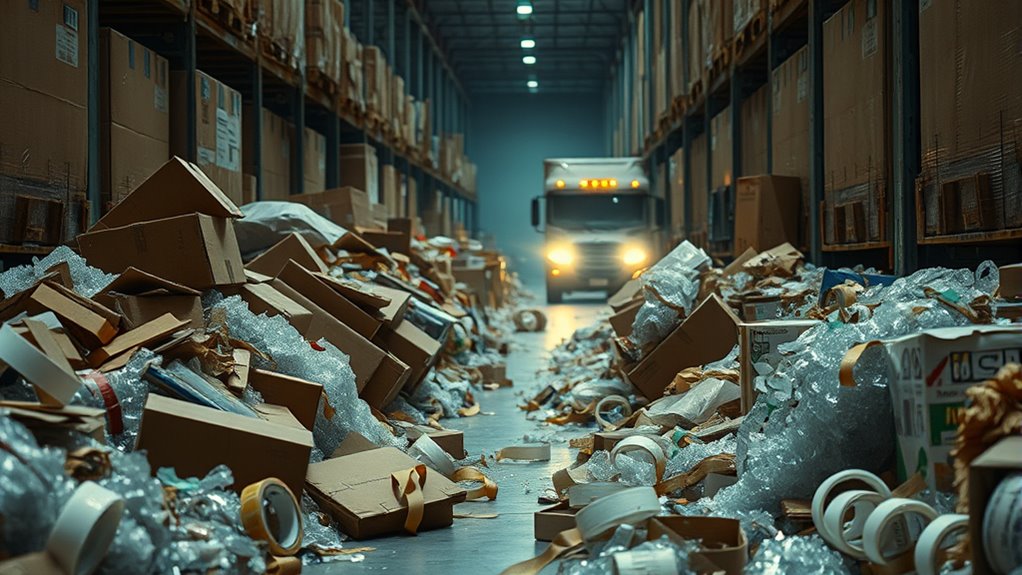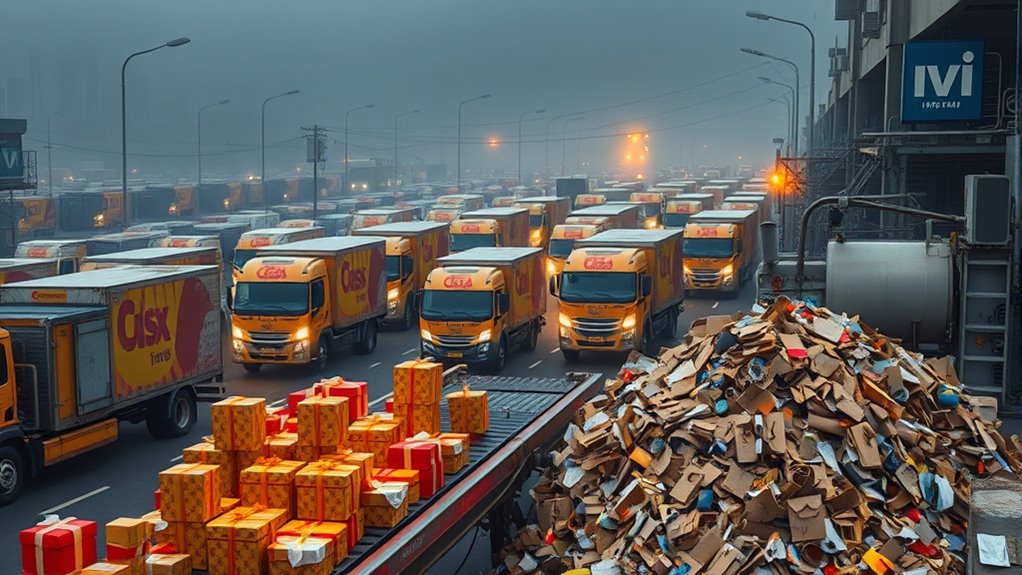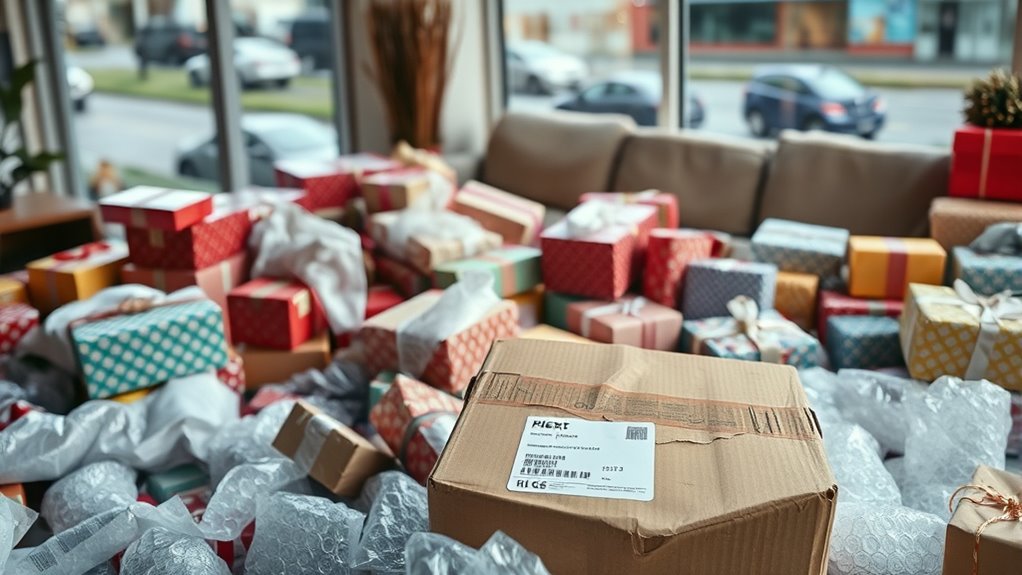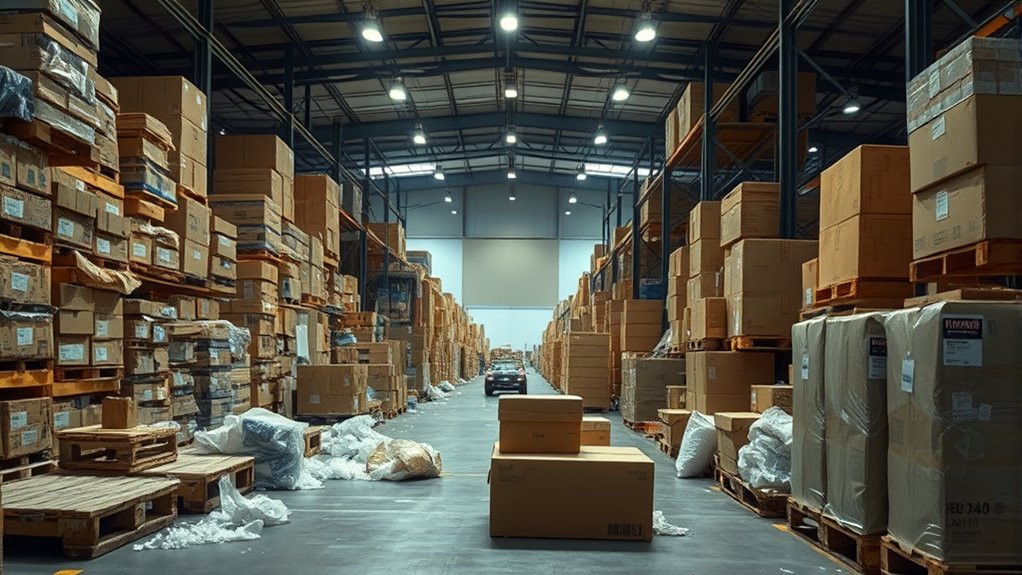Overnight shipping for gifts boosts convenience but comes with significant environmental costs. It increases emissions due to faster transport methods, often relying on fuel-powered vehicles that pollute more. Additionally, it leads to packaging waste and traffic congestion in city centers, worsening pollution. More delivery trucks on the road also mean higher carbon footprints. If you want to understand how your choices impact the planet and discover eco-friendly options, there’s more to explore.
Key Takeaways
- Overnight shipping significantly increases fuel consumption and emissions due to expedited delivery routes and less efficient logistics.
- Faster delivery options contribute to urban congestion, leading to higher pollution and greenhouse gas emissions.
- Rapid shipping generates more packaging waste, often involving non-recyclable materials that burden landfills and ecosystems.
- The use of fuel-powered vehicles for overnight deliveries raises concerns about carbon footprint and environmental pollution.
- Consumers opting for overnight shipping can influence companies to adopt more sustainable practices and reduce environmental impacts.
The Rise of Same-Day and Overnight Shipping: A Growing Trend

In recent years, the demand for faster delivery options has surged, making same-day and overnight shipping increasingly popular. This trend transforms urban logistics, as companies race to meet customer expectations for quick arrivals. However, the rapid rise in these services intensifies delivery congestion in city centers, straining infrastructure and resources. As more packages are dispatched in shorter timeframes, couriers navigate crowded streets, leading to delays and increased fuel consumption. This surge also compels logistics providers to optimize routes and expand delivery fleets, which can further worsen urban congestion. While consumers enjoy instant gratification, the broader impact on city traffic and infrastructure becomes more evident, highlighting the challenges of balancing rapid delivery with sustainable urban logistics management.
Carbon Footprint of Rapid Delivery Services

The rapid growth of same-day and overnight delivery services considerably increases the carbon footprint of urban logistics. These services rely heavily on fuel-powered vehicles, which emit significant greenhouse gases. To reduce this impact, some companies are investing in recycling initiatives to optimize routes and cut waste, lowering overall emissions. Additionally, more delivery providers are shifting toward renewable energy sources, like electric vehicles and solar-powered facilities, to lessen their environmental impact. While these efforts help, the surge in delivery volume still results in higher carbon emissions compared to traditional shipping. As a consumer, your choices influence this trend—opting for slower, eco-friendly options can make a difference. Ultimately, balancing convenience with sustainability requires ongoing innovation and commitment from delivery services. Awareness of spoiled lemon juice and other environmentally friendly habits can also contribute to a more sustainable lifestyle. Implementing sustainable logistics practices remains essential to minimizing the environmental toll of rapid delivery services. Furthermore, increasing consumer awareness about carbon emissions from delivery can encourage more responsible shipping choices.
Packaging Waste and Its Environmental Impact

As delivery services ramp up overnight shipping, packaging waste has become a significant environmental concern. You generate a lot of waste from excessive packaging, much of which ends up in landfills. Many companies now use recyclable materials to reduce this impact, but not all packaging is eco-friendly. Single-use plastics and non-recyclable materials contribute to pollution and harm wildlife. Switching to eco friendly packaging options, like biodegradable fillers and recyclable boxes, can lessen this burden. However, the convenience of quick delivery often leads to over-packaging, increasing waste and environmental strain. Reducing packaging waste requires conscious choices from both consumers and companies. By prioritizing recyclable materials and food safety, like biodegradable fillers and recyclable boxes, you can help minimize the environmental footprint of overnight shipping. Incorporating sustainable packaging practices is essential for long-term environmental health.
The Role of Transportation in Emissions and Pollution

Transportation plays a significant role in the environmental impact of overnight shipping, contributing heavily to emissions and pollution. Your choice of transportation methods influences how much greenhouse gases and pollutants enter the atmosphere. For example:
- Switching to electric vehicles can drastically reduce tailpipe emissions, making deliveries cleaner.
- Using alternative fuels like biodiesel or hydrogen helps cut down on carbon footprint and air pollution.
- Optimizing delivery routes minimizes fuel consumption, lowering overall emissions.
- Incorporating Honda Tuning enhancements such as improved engine efficiency can further reduce emissions from delivery vehicles.
- Implementing advanced telematics systems can improve fleet management and reduce unnecessary idling, thereby decreasing emissions.
Making Sustainable Choices in a Fast-Paced Gift Economy

In a fast-paced gift economy, making sustainable choices requires balancing immediate needs with long-term environmental impacts. You can start by choosing eco-friendly packaging that reduces waste and minimizes plastic use. Opt for recyclable materials and support brands committed to sustainable practices. Participating in recycling initiatives ensures that packaging and gift materials are repurposed rather than discarded prematurely. When shopping, prioritize local or small businesses that use sustainable shipping methods, reducing carbon emissions associated with overnight deliveries. Consider giving experiences or digital gifts instead of physical items, which cut down on packaging waste altogether. Additionally, being aware of the environmental cost of overnight shipping can motivate more mindful purchasing decisions. Understanding the environmental impact of delivery options encourages consumers to choose more sustainable alternatives whenever possible. These small but meaningful steps help you stay environmentally conscious without sacrificing the joy of giving, making a positive difference in the fast-moving world of gift exchange.
Frequently Asked Questions
How Do Companies Offset the Environmental Impact of Overnight Shipping?
You can reduce the environmental impact of overnight shipping through carbon offsetting, where companies invest in projects that absorb or reduce emissions. They also use sustainable packaging to minimize waste and resource use. By choosing eco-friendly materials and supporting initiatives that lower their carbon footprint, companies show their commitment to sustainability, helping you enjoy fast delivery without compromising the environment.
What Are Alternative Eco-Friendly Options for Last-Minute Gift Delivery?
If you’re looking for eco-friendly last-minute gift delivery options, consider using reusable packaging to reduce waste. You can also choose local courier options, which often have smaller carbon footprints compared to national carriers. These alternatives help you get your gifts delivered quickly without causing significant environmental harm. By opting for reusable materials and supporting local services, you contribute to a more sustainable approach to gift-giving.
How Does Overnight Shipping Affect Local Versus Global Supply Chains?
Imagine a web connecting every gift, where overnight shipping pulls at its threads. This rush often favors global supply chains over local manufacturing, disrupting regional logistics. Your choices impact these networks; prioritizing speed can weaken local economies and increase environmental strain. By understanding this, you see how swift deliveries stretch beyond convenience, shaping the resilience of communities and the environment alike. Think twice before hitting that express button.
Are There Eco-Certifications for Sustainable Rapid Delivery Services?
You might wonder if eco-certifications exist for sustainable rapid delivery services. Yes, some companies pursue green logistics certifications that meet eco label standards, showing their commitment to reducing environmental impact. These certifications verify they follow eco-friendly practices, like efficient routing and eco-conscious packaging. By choosing services with such labels, you support greener logistics and help lessen the environmental footprint of quick delivery, making your gift-giving more sustainable.
What Policies Could Governments Implement to Reduce Shipping Emissions?
Have you ever wondered how governments can cut shipping emissions? They can implement policies promoting urban planning that reduces delivery distances, making logistics more efficient. Encouraging the use of renewable energy in transportation also plays a crucial role. By incentivizing sustainable practices and investing in infrastructure, governments can markedly lower environmental impacts. These policies not only help the planet but also foster smarter, greener cities for everyone’s benefit.
Conclusion
As you chase the convenience of overnight shipping, remember that each quick delivery adds to our planet’s burden. It’s a coincidence, really—your desire to surprise someone today can unintentionally harm tomorrow’s world. By making small, thoughtful choices, you can break this cycle. When you opt for greener options, you’re not just giving a gift—you’re giving hope for a healthier, cleaner future. Sometimes, slowing down is the biggest gift you can give.









